Police of Denmark
The police of Denmark (Danish: Politiet, Faroese: Løgreglan, Greenlandic: Politiit)) is the interior part of the Danish security forces (the Danish military being the exterior) in the Kingdom (The unity of the Realm: Denmark (proper), Greenland, Faroe Islands). The police are empowered to enforce the law and to effect public and social order, as well as being responsible for border control.[2]
| State Police Politiet | |
|---|---|
| Motto | Insight, vision and foresight [1] |
| Agency overview | |
| Formed | 1919 |
| Jurisdictional structure | |
| National agency | |
| Governing body | Rigspolitiet |
| General nature | |
| Operational structure | |
| Headquarters | Copenhagen |
| Civilians | 14 000 |
| Website | |
| www.politi.dk | |
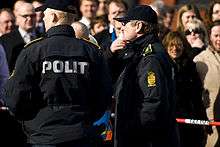

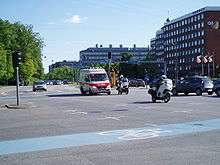
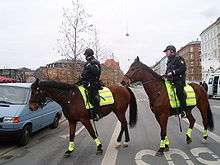
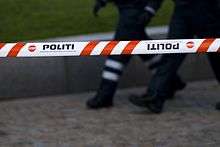
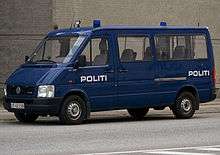
Organization
The police of Denmark consists of 12 districts each managed by a director and two minor districts in Greenland and the Faroe Islands, run by a local chief of police. The district of Copenhagen is somewhat differently organized due to its size and tasks.
Besides the regular districts other organizations exist that work outside the general police:
- Rigspolitiet - a nationwide police force with specialized tasks such as Budgets and Accounts, Building Surveying Department and the Data Investigating Department
- Politiets Efterretningstjeneste - the national security intelligence agency of Denmark
- Politiets Aktionsstyrke - the special forces unit of the Danish police
Equipment
Uniform
The common uniform is a light blue shirt with the police insignia on the sleeve. Usually a tie is also worn. Rank-insignia is worn on the shoulders. The trousers are dark blue with reflective patches. Black shoes are also included in the standard uniform. Special tactical suits are made of flame-resistant materials and are worn in situations requiring such equipment. The tactical suit also includes a protective helmet.
Vehicles
For daily duties, the patrol-vehicles are white and dog-patrols are mostly dark blue. They have a blue strobe-light or flashing light and the word "POLITI" painted on the side in clear reflective paint. The most commonly used patrol vehicles are Ford Mondeo, Volkswagen Passat and Opel Vectra, with 2.0 to 2.2 litre engines. In 2009, the 3.6 litre Škoda Superb was added to the fleet. Unmarked cars are usually fitted with engines with a size of around 1.6 to 2.2 litres. In addition a large number of small unmarked cars are used like Peugeot 307, Opel Astra, Ford Focus and Toyota Yaris - with engine size of around 1.2 to 1.6 litre. The Peugeot 607 is used by a security attachment for cabinet members and the royal court. The Toyota Landcruiser and VW Touareg are used for special tasks. Small detachments typically use VW Transporters, while VW LTs and Ford Transit mini-buses are used in larger operations, which require a lot of manpower (demonstrations, football matches and larger civil unrests). In extreme events, a variation of the MB Vario is used. It is generally known as the Dutchman's vehicle (in Danish Hollændervogn). This name derives from the fact that these vehicles are kitted out in the Netherlands as light APC's with reinforced windows, wheels and metal parts and fire-resistant coating. They are used both as light APCs in event of demonstrations or public disturbances, and as general transportation of large numbers of detainees. Other vehicles in use are the Mercedes-Benz Vito (used by both Central Patrol Leaders, a kind of on-street watch commanders) and Nissan Patrols used by the mounted police squads with a horse carrier attached.
The traffic police also use unmarked vans for automatic traffic control. These are primarily VW Transporters, Mercedes Benz Vitos, Toyota Hiaces, but others are used as well.[3]
Some rural police officers use civilian vehicles with a dismountable magnetic roof beacon.
For traffic regulation and VIP and ambulance escorts motorcycles are also used, primarily Yamaha FJR1300A, Honda ST1300a,[4] BMW K1200RS and BMW K1200GT (over time replacing older BMW K1100LT and BMW R1100RT).
Weapons
The standard service handgun is the H&K USP Compact 9mm pistol. For special tasks the H&K MP5 sub-machine gun is used. Officers are also equipped with batons and pepper spray cans.[5]
Law about police enforcement
The operation of Danish police is regulated in the Act on Police Enforcement (da: Lov om politiets virksomhed), commonly known as The Police Act (da: politiloven) of 20 August 2015.[6]
Its first section states that:
"The police must work to ensure security, safety, peace and order in society. The police must promote this purpose through prevention, assistance and enforcement."
The second section states that other areas of police jurisdiction include:
- preventing criminal actions, disturbances of the public peace and order and danger to individual citizens and public safety
- stopping criminal actions and investigating and prosecuting criminal actions
- supporting citizens in dangerous situations
- carrying out checking and inspecting under current rules and regulations
- supporting other agencies under current rules and regulations
- performing other tasks under current rules and regulations, as well as handling other tasks which are naturally associated with police duties.
Lastly, the third section states: "The police may in other situations than those mentioned in statutory law only interfere with citizens under this Act."[note 1]
Ranks and insignia
In Denmark, the local prosecution service is part of the police. Since 2014, only Chief Prosecutors wear uniforms; other prosecutors, such as senior prosecutors, prosecutors, associate prosecutors, and advocates, do not.
| Rank | Rank titles[7] | Rank insignia[7] | Personnel category | English equivalent |
|---|---|---|---|---|
| 1. | Rigspolitichef | Senior manager | Police commissioner | |
| 2. | Politidirektør Direktionsmedlem i Rigspolitiet Politimester i PET Politimester i Grønland Politimester på Færøerne | Senior manager | Chief constable | |
| 3. | Stabschef Afdelingschef i Rigs- politiet | Senior manager | Assistant Chief Constable | |
| Chefanklager | Lawyer | Chief Crown Prosecutor | ||
| Chefpolitiinspektør | Police | Chief Superintendent | ||
| 4. | Vicepolitimester i Grønland Vicepolitimester på Færøerne Vicepolitimester i Rigspolitiet Politiinspektør | Police | Superintendent | |
| 5. | Vicepolitiinspektør | Police | Police Inspector | |
| 6. | Politikommissær | Police | Police Sergeant | |
| 7. | Politiassistent | Police | Police Constable with 12 years service | |
| 8. | Politiassistent | Police | Police Constable with 7 years service | |
| 9. | Politibetjent | Police | Police Constable | |
| 10. | Politikadet | Police | Police Cadet |
Military police
The military police (MP) in Denmark are police units within the armed forces branches. Each branch has its own MP corps, although they often work together and wear similar insignias.
MP personnel typically wear either specific display dress uniforms with white MP shoulder markings or the branch-common daily battle dress uniforms with a red beret.
MP personnel generally do not have any legal jurisdiction over civilians in non-military locations, but only over military personnel and over everyone on military installations (also publicly accessible places such as the Holmen Naval Base in Copenhagen), in the buildings housing the Ministry of Defence, royal palaces (like Amalienborg Palace) and parts of Christiansborg Palace. On some occasions, MP personnel can provide support to the civilian police for certain tasks, but will only have slightly more legal authority than civilians, similar to the police home guard.
Police Home Guard
.jpg)
The Danish police can call upon assistance from a section of the Danish home guard: Politihjemmeværnet the police home guard. The police home guard consists of 47 companies, each led by professional police officers.
The volunteers are mainly used for traffic control at festivals, searches for victims and guarding community installations and are never used in tasks involving direct confrontation with civilians (riot control or planned arrests). These companies are part of the Army Home Guard.[8]
They wear branch-common daily battle dress uniforms, green berets and bright yellow vests with the text "POLITI HJEMMEVÆRNET" (POLICE HOME GUARD).
Members of the police home guard have slightly more legal authority than regular citizens when the service they provide calls for it, but they are always under the supervision of the civilian police.
See also
Notes
- Though this may seem obvious, it is a precaution that clearly states that the police may under no circumstances act towards the citizens in ways not stated by law (da: hjemlet). This ensures that the police cannot make their own interpretations of laws or regulations.
References
- "About Police (danish: Om Politiforbundet)". Politiforbundet.
- "Annex 1: List of national services responsible for border control" (PDF). Practical Handbook for Border Guards (Schengen Handbook). European Commission. 6 November 2006. Retrieved 7 November 2018.
- "Fotovogne i Danmark" [Photo vehicles in Denmark]. 10-20.dk (in Danish). Archived from the original on 20 October 2007. Retrieved 7 November 2018.
- "Politiet får nye motorcykler" [Police get new motorcycles]. Politi.dk (in Danish). 22 September 2005. Retrieved 7 November 2018.
- Olsen, Frode Z. (2008). "The use of police firearms in Denmark" (PDF). Politi.dk. Retrieved 28 October 2014.
- "Lov om politiets virksomhed" [Law on Police Activity]. Retsinformation.dk (in Danish). Retrieved 7 November 2018.
- "Distinktioner I Politiet" [Danish Police rank insignia] (PDF). Politi.dk (in Danish). July 2017. Retrieved 7 November 2018.
- "Hærhjemmeværnet" [The Home Guard]. Vistillerop.dk (in Danish). Retrieved 7 November 2018.
.svg.png)